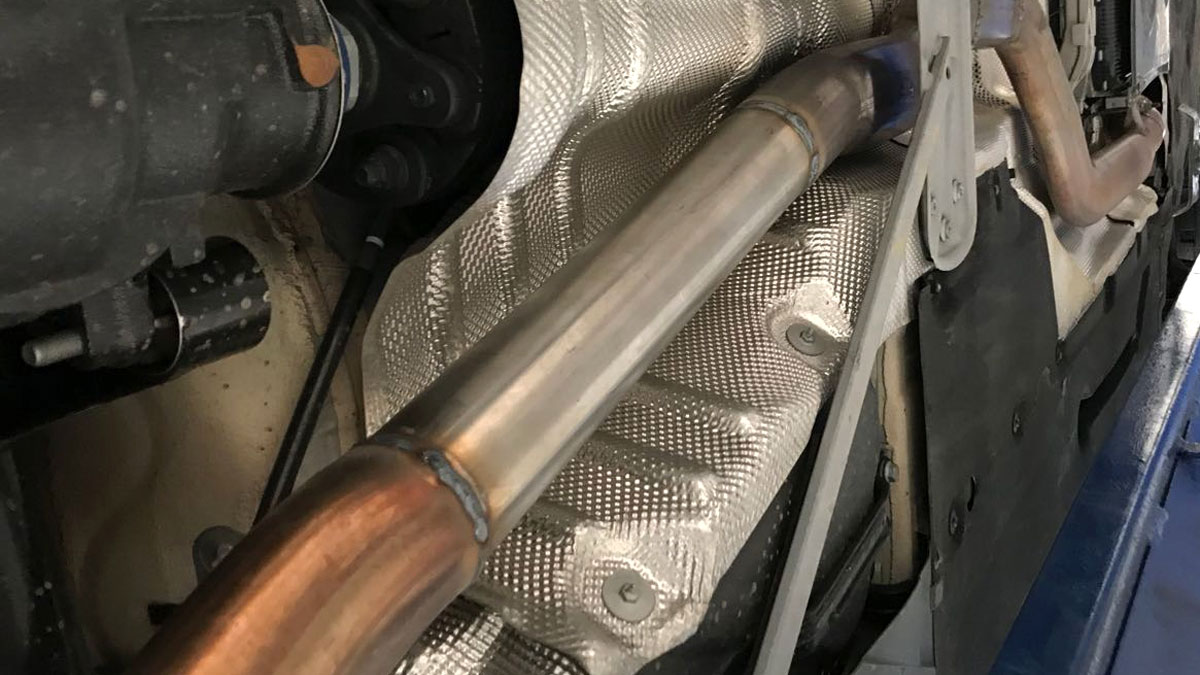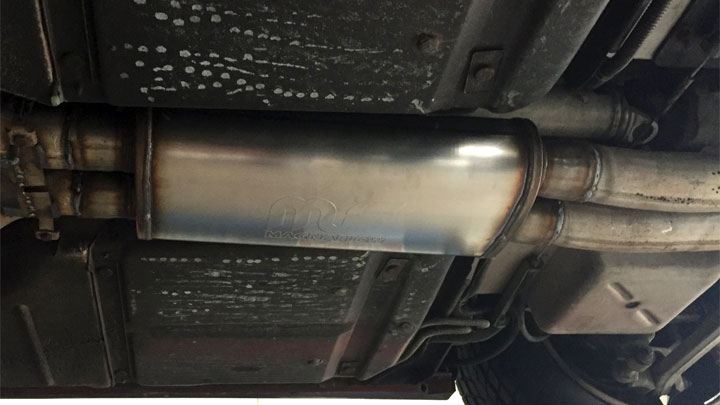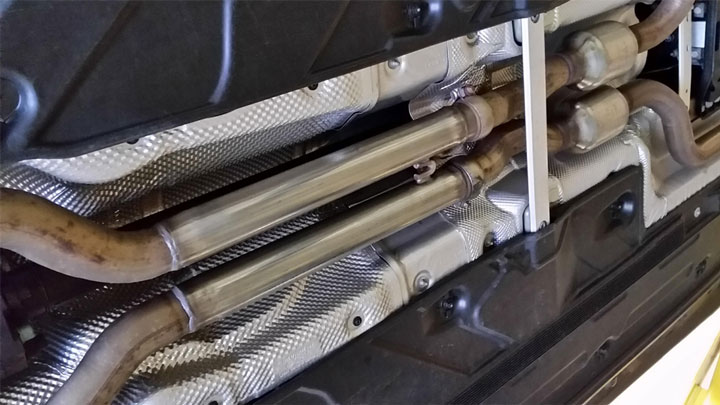Resonator Delete Pros and Cons (and Average Cost)
You may be surprised to learn that your car or truck’s exhaust includes not only a muffler, but a resonator as well. Maybe even two.
I can recall resonators on automobiles as far back as the fifties. Being a car nut as a very young guy, I noted them on my dad’s cars. I’d ask and my dad would tell me, “The resonator softens and changes the engine sound out the exhaust”. And he was right.
But what if you didn’t want to soften the engine sound? Going without the resonator can uncork that raspy roar of some vehicles and give it a more aggressive sound. But do these pros outweigh the cons of a resonator delete?

Related: Resonator vs Muffler Comparison
What Is a Resonator?
A resonator is a type of muffler that can be anywhere from about 15 inches to 3 ft. in length. Its function is not to muffle engine exhaust sound. The muffler does that job. The resonator is designed to modify that sound.
Decades ago, resonators were located between the muffler and the exhaust tip. Since those ancient days, resonators have found a new home. They are now installed between the catalytic converter and the muffler.
How Does a Resonator Work?

As the name ‘resonator’ implies, this device uses resonances (harmonic reinforcing reflections of sound pulses) inside the exhaust system to cancel certain frequencies of engine sounds while enhancing others.
The exhaust system engineers will ask, “What sound do we want out of the exhaust pipe for this car? A smooth performance sound? A sharp biting sound? A soothing quiet sound? A deep rumble?”
The resonator then is tuned to give the sound that the designers (and probably the sales folks) believe will fit the car or truck’s image.
My favorite examples of this are the Alfa Romeo Spiders, vintage 1962 through 1993. These cars, with mere 4 cylinder engines, produced a classic ROWERROOOMMM sound. Through the clever use of a resonator this pleasant sound was crafted and proved to be a trademark of sorts for these cars over their lifetime
Modern resonator usage can be for either enhancing a performance exhaust sound or for quieting an uncomfortable high frequency howl or low frequency drone. It can also help to almost completely silence an engine’s exhaust.
Types of Resonators
There are three varieties of resonators each with a slightly different function.
#1 – Helmholtz or Chambered Resonator
This type of resonator is intended to cancel certain specific sound frequencies that the car’s muffler cannot handle. These are seldom flow-through designs but are dead-ended and are welded into the side of the exhaust pipe.
At the end of the device pipe sits a multi-chambered housing which does the sound deadening work.
#2 – Dissipative Resonator
Designed much like small cylindrical mufflers this design allows exhaust flow through a louvered internal housing. Sound deadening chambers of varying sizes surround this internal housing and may be filled with glass fibers or may be empty depending on the frequencies to be dissipated.
#3 – Expansion Chamber Resonator
This design incorporates varying internal tube diameters to form one or more specific size chambers. The diameter transitions work to create sound pulse reflections back into the exhaust flow.
This design can be effective to cancel high frequency sounds. The effect at the tail pipe will be a much lower frequency exhaust note.
What Is a Resonator Delete?

A resonator delete is the removal of the resonator(s) from your car’s exhaust system. There are pros and cons to taking this step with your car or truck. Let’s discuss possible pros and cons.
We say ‘possible’ here because changing any exhaust part on most of todays’ cars could have unpredictable results. The engine systems are quite complex and exhaust system performance is integrated into that complexity mix. Some hoped-for advantages may be offset by unexpected performance losses.
It’s unlikely that you will be able to accurately predict what will change before you begin this job. So in making such a change do not destroy or discard the parts removed. You may soon need to put that resonator back in place.
Resonator Delete Pros

The following benefits could accrue should you decide to remove your car’s resonator:
#1 – More Sporty Exhaust Sound
Keep in mind, your car may sound more sporty to you, but it may just be louder to your next door neighbor.
#2 – Less Weight
There will be a slight weight reduction. Very slight and considering a car weighing in at say, 3,200 lbs., it is likely that any benefit will be virtually undetectable. If you were building a race car, a small weight benefit would make sense. But for a race car there would be no need for a resonator.
#3 – More Power
A slight engine performance increase is to be expected. Experts say you might gain 3 to 5 additional horsepower by removing the resonator. As with the weight benefit above, this amount of power change will not be easily noticeable.
#4 – Better Gas Mileage
There may be a slight improvement in fuel economy. Just as with horsepower gain, any improvement here will be negligible.
Resonator Delete Cons

The following problems could result if you removed your car’s resonator. Some may be very unlikely to occur but are still worth mentioning.
#1 – Louder Exhaust
Excessively loud exhaust sound. Low frequency droning or high frequency howls. Creation of a very buzzy sounding exhaust.
#2 –Rattling
Alteration of exhaust piping may cause pipe rattles or knocks against adjacent structure.
#3 – Less Power
In some cases, there may be a small power reduction with a resonator removal. The manufacturer may have found that the resonator enhances exhaust flow thereby benefiting engine power output. You have removed that. Such a performance change would be small and nearly undetectable.
#4 – Worse Gas Mileage
If a power reduction occurs, it may be accompanied by a small decrease in fuel economy. This change may be negligible.
#5 – Check Engine Light
Though unlikely with only a resonator delete, an OBD II code may be set and indicated with a Check Engine Light. The Onboard Diagnostic System monitors emissions systems operation. The exhaust system is part of the emissions system. Making changes to the exhaust system may affect one or more emissions sensors leading to one or more OBD II fault codes.
#6 – Premature Failure of Replacement Parts
You have installed the resonator delete parts in the space where the factory original resonator was located. The new parts installed may not be of the same quality as the original factory parts. This could lead to a premature failure of the exhaust system such as leakage and/or complete exhaust pipe breakage. Such failures would not likely be covered by your vehicle warranty.
Is a Resonator Delete Legal?
Your state may have restrictions on modifications to your car’s exhaust system. Before undertaking this change to the exhaust piping it would be wise to contact your local motor vehicle office to determine if removing your car’s resonator is legal.
Will a Resonator Delete Pass Emissions?

In regards to emissions tests which assess actual exhaust products out the tailpipe, deleting the resonator will have no adverse effects. However, your state may not pass your emissions inspection because you have modified the exhaust system. Check with your local motor vehicle office to see if this might be an issue.
And, last, deleting the resonator may have caused your OBD II system to set a code and illuminate the Check Engine Light. If that is the case your car will not pass the emissions inspection until that fault is corrected.
Resonator Delete vs Muffler Delete

Because the muffler is the primary sound mitigating device in your car’s exhaust system, some folks advocate removing it to enhance engine sound instead of removing the resonator.
This article will provide more insights into the pros and cons of making this change to your car: https://cartreatments.com/muffler-delete/
Other Alternatives to a Resonator Delete
Of course, you can remove your complete exhaust system and replace it with what is referred to as a straight pipe system. The potential benefits and problems for this change are explained in this article: https://cartreatments.com/straight-pipe-exhaust/
And if your only objective is to make your exhaust louder there are other options. See this article for more information: https://cartreatments.com/how-to-make-exhaust-loud/
How Much Does a Resonator Delete Cost?
Removing your car’s resonator is not costly. For a single exhaust, kits which provide a replacement pipe and associated parts can cost as little as $100. To have this done by a muffler shop could cost as much as $300 including parts.
A dual exhaust resonator removal could nearly double this cost.
If My Car Has No Resonator, Should I Install One?
Late Model Cars
The benefits of a resonator have been analyzed by your car’s manufacturer. They have concluded that no resonator is needed. Considerable analysis and testing has probably accompanied this decision. For this reason, it is unlikely that purchasing a resonator kit and adding it to your car’s exhaust system will bring any significant benefit.
If your car is still under the manufacturer’s warranty, adding a resonator could be a warranty violation. Check with your dealer on this.
Older Cars
If your car is more than five years old and out of its warranty period, adding a resonator (or two with dual exhaust) could offer some benefits.
You would have to assess your particular need (for example, droning or howling exhaust, medium speed excess noise, etc.). Then you would have to select one of a number of different aftermarket resonators available from a reputable source.
You should be cautious because the desired improvement may not be attainable. There is no way to pre-determine if a resonator would add any benefit to your car’s exhaust note. And at least one of the disadvantages and cautions with removal of a resonator as discussed above would apply to adding such a device to your car.
- DIY Car Repair Tools – Floor Jack and Jack Stands - Dec 12, 2023
- DIY Car Repair Tools – Socket (Ratchet) Wrench - Nov 9, 2023
- DIY Car Repair Tools – Torque Wrench - Apr 20, 2023
